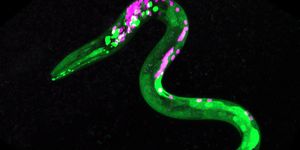African Open Habitats Existed 10 Million Years Earlier Than Previously Estimated
Scientists have long hypthesized that apes living in Africa more than 20 million years ago had a diet largely comprised of fruit while living in a continet-wide ecosystem comprised of thick, closed canopy of endless trees. Researchers at the University of Minnesota Twin Cities recently published two studies in Science that help shed might on the development of open habitats in Africa, and indicate such habitats existed 10 million years earlier than previously estimated. This new study also alters the previous hypothesis by suggesting apes had a diet largely comprosed of leaves while living in more open environemnts, as well.
Researchers were able to reconstruct African open habitats through a variety of data collection methods. (Credit: Corbin Rainbolt)
For the study, 30 experts from institutions in North America, Africa, and Europe gathered data from nine fossil sites encompassing thousands of animal remains and fossil plants and fossil deposits to rebuild ancient habitats that existed in Africa millions of years ago. Their findings indicated habitats for early apes existed between 23 and 16 million years ago known as the Early Miocene, which is approximately 10 million years earlier than scientists have previously predicted.
“You go into a project like this not knowing for sure what you will find out, which is exciting,” said Dr. David Fox, who is a professor in the Earth and Environmental Sciences Department at Twin Cities, and a co-author on the two studies. “In this case, we realized we were looking at a picture of Early Miocene communities in eastern Africa that is quite different than what we had expected. There was no single ‘ah ha moment’ but over years of field seasons and the steady accumulation of new fossils and new data, we realized that the environments of the earliest apes varied significantly from the traditional picture of forested habitats.”
The study’s findings included identifying a large amount of C4 plant biomass, which was previously hypothesized to exist 10 million years ago, identifying the evolution of modern ape anatomy of leaf-eating apes instead of forest-dwelling, fruit-eating apes. This has led the researchers to believe that previous notions of the evolution of open habitats should be reconsidered.
"The findings have transformed what we thought we knew about early apes, and the origin for where, when and why they navigate through the trees and on the ground in multiple different ways," said Dr. Robin Bernstein, who is the program director for biological anthropology at the National Science Foundation. Dr. Bernstein emphasizes how the research accomplished for this study establishes a foundation for future research pertaining to ape evolutionary origins.
In conclusion, the researchers recommend reevaluating how ancient habitat heterogeniety could be connected to certain specializations, including bipedality and dental and foraging.
What new discoveries will scientists make about the evolution of apes in the coming years and decades? Only time will tell, and this is why we science!
Sources: Science, University of Minnesota
As always, keep doing science & keep looking up!









